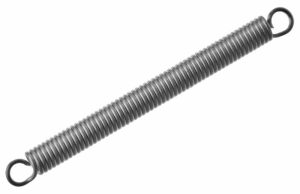
Extension springs are commonly used in furniture, household appliances, garage doors and countless other everyday products. Also known as tension springs, they are designed to operate under a tension load. Here are six facts about extension springs.
#1) Create a Pulling Force
While other types of springs may create a pulling force, extension springs create a pulling force. When exposed to a tension load, they will store mechanical energy while simultaneously creating a pulling force. Therefore, you can use an extension spring to hold two components together. As it creates a pulling force, it will prevent the components from separating.
#2) Typically Features Hooks on the Ends
You can find extension springs in different styles, but most of them have hooks on the ends. There’s a single hook at each end. What’s the purpose of these hooks exactly? They allow the extension springs to connect to components. You can slide the hooked ends of an extension spring over the components.
#3) Opposite of Compression Springs
Extension springs are essentially the opposite of compression springs. There are over a dozen types of springs, but most of them fall under one of two categories: extension or compression. Extension springs are designed to operate under a tension load, meaning they become longer while creating a pulling force. Compression springs, in comparison, are designed to under a compression load, meaning they become shorter while creating a pushing force.
#4) Made of a Single Piece of Metal
Most extension springs are made of a single piece of metal. The metal stock is placed into a machine known as a former. The former will then bend the metal to manipulate it into a coiled shape. Some extension springs are made of stainless steel, whereas others are made of carbon steel or music wire steel. Regardless, most extension springs consist of a single piece of metal in a coil shape.
#5) Designed to Stretch Up to a Specific Length
Extension springs are designed to stretch up to a specific length. This maximum stretch length is known as an extension limit. While under a tension load, an extension spring will begin to stretch while becoming longer. It will only stretch up to the spring’s extension limit, however.
#6) Stretch Is Determined By Several Factors
Several factors affect the strength of an extension spring. Some of these factors include the material, thickness and length. Generally speaking, the longer and thicker an extension spring is, the stronger it will be.
